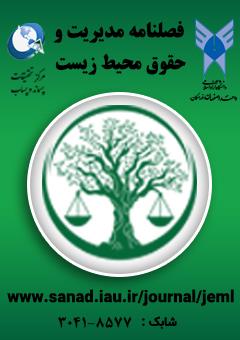مدلسازی پراکندگی ذرات معلق PM10 در اثر احداث و بهرهبرداری از طرح تولید بیلت و لولههای فولادی با استفاده از نرمافزار AERMOD(مطالعه موردی: شهرستان آشتیان)
محورهای موضوعی : ارزیابی اثرات زیست محیطی
زهرا جوهری
1
,
رضا پیکانپور فرد
2
,
مریم نصری نصرآبادی
3
*
![]()
1 - دانشجوی دکتری، دانشگاه آزاد اسلامی، واحد اصفهان(خوراسگان)، اصفهان، ایران
2 - دانشکده منابع طبیعی، دانشگاه صنعتی اصفهان، اصفهان، ایران
3 - دانشجوی دکتری، دانشگاه آزاد اسلامی، واحد اصفهان(خوراسگان)، اصفهان، ایران.
کلید واژه: كمىسازى, آلودگی هوا, ذرات معلق, AERMOD,
چکیده مقاله :
آلودگی هوا به عنوان یک پدیده پیچیده و چند وجهی، به طور فزایندهای جوامع صنعتی و شهری را تحت تأثیر قرار داده است. ذرات معلق (PM) به عنوان یکی از آلایندههای اصلی هوا، کیفیت زندگی شهری را به شدت تحت تأثیر قرار میدهند. این ذرات به دلیل قابلیت نفوذ به عمق ریهها و ورود به جریان خون، عامل بسیاری از بیماریهای حاد و مزمن تنفسی و قلبی عروقی هستند. هدف از اين پژوهش مدلسازی پراکندگی و غلظت آلایندههای هوا در اثر احداث و بهرهبرداری از طرح مورد نظر است. در اين مطالعه به جهت مدلسازى آلايندههاى هوا از نرمافزار AERMOD استفاده گرديد. اين نرمافزار ميزان آلودگى هواى مربوط به آلايندهها را در يك مكان مشخص با استفاده از دادههاى هواشناسى، مدل رقومى ارتفاع و اطلاعات مربوط به منابع آلاينده، ارزيابى و كمىسازى مىكند. نتایج مدلسازی پراکندگی آلایندهها، حداکثر غلظت PM10، به میزان 47/9 میکروگرم بر مترمکعب را نشان داد که کمتر از استاندارد حداکثر غلظت 24 ساعته بود. بنابراین طرح مورد نظر از لحاظ حداکثر غلظت 24 ساعته ذرات معلق بدون در نظرگرفتن پس زمینه کمتر از حد استاندارد است و تهدیدی برای کیفیت هوا محسوب نمیشود.
Air pollution, a complex and multidimensional phenomenon, has increasingly affected industrial and urban communities. Particulate matter (PM), as a primary air pollutant, significantly affect quality of life in urban areas. These particles, due to their ability to penetrate deep into the lungs and enter the bloodstream, are responsible for numerous acute and chronic respiratory and cardiovascular diseases. The aim of this research is to model the dispersion of air pollutants resulting from the construction and operation of the proposed project. In this study, the AERMOD software was used to model air pollutants. This software evaluates and quantifies the level of air pollution related to pollutants at a specific location using meteorological data, a digital elevation model, and information related to pollution sources. The results of the dispersion modeling of pollutants showed a maximum concentration of PM10 of 47.9 micrograms per cubic meter, which was lower than the maximum 24-hour standard. Therefore, the proposed project, in terms of the maximum 24-hour concentration of suspended particles, excluding the background, is below the standard limit and does not pose a threat to air quality.
Abbaspour, M. (2012). Air pollution modeling. First. Sharif University of Technology, 9-1. [In Persian]
Bayat, R., Hassanvand, M. S., & Daroudi, R. (2020). Economic analysis of the cost of air pollution deaths in Tehran. Urban Economics and Planning, 1(3), 188-197. [In Persian]$
Bayraktar, O. M., & Mutlu, A. (2024). Analyses of industrial air pollution and long-term health risk using different dispersion models and WRF physics parameters. Air Quality, Atmosphere & Health, 1-29.
Deary, M. E., & Griffiths, S. D. (2021). A novel approach to the development of 1‐hour threshold concentrations for exposure to particulate matter during episodic air pollution events. Journal of Hazardous Materials, 418, 126334.
EPA (2012). AERMOD User's Guide. Environmental Protection Agency.
Esmaeilzadeh, M., Bazrafshan, E., Nasrabadi., M. (2013). Dispersion Modeling of NOX and SO2 Emissions from Tous Gas Power Plant. Health & Environ, 6(1), 77-90. [In Persian]
Liu, W., Xu, Z., & Yang, T. (2018). Health effects of air pollution in China. International journal of environmental research and public health, 15(7), 1471.
Manisalidis, I., Stavropoulou, E., Stavropoulos, A., & Bezirtzoglou, E. (2020). Environmental and health impacts of air pollution: a review. Frontiers in public health, 8, 14.
Prasad, N., Mishra, A., Bhattacharya, T., Lal, B., Chandra Jha, P., & Kumar, A. (2024). Validation of AERMOD prediction accuracy for particulate matters (PM10, PM2. 5) for a large coal mine complex: A Multisource Perspective. Aerosol Science and Engineering, 1-15.
Salahi, B., & Behrouzi, M. (2023). Evaluation of the distribution of exhaust air pollution from the chimneys of Tabriz Oil Refinery using AERMOD model. Researches in Earth Sciences, 14(1), 86-101. [In Persian]
Seihei, N., Farhadi, M., Takdastan, A., Asban, P., Kiani, F., & Mohammadi, M. J. (2024). Short-term and long-term effects of exposure to PM10. Clinical Epidemiology and Global Health, 27, 101611.
Statistical Yearbook of Markazi Province. (2016). [In Persian]
USEPA. (2022). AERMOD: Description of Model Formulation and Applications. United States Environmental Protection Agency.
WHO. New WHO Global Air Quality Guidelines Aim to Save Millions of Lives from Air Pollution. 2022. Available online: https://www.who.int/news/item/22-09-2021-new-who-global-air-quality-guidelines-aim-to-save-millions-of-lives-from-air-pollution .
Zehtab Yazdi, Y., Mansouri, N., Atabi, F., & Aghamohammadi, H. (2021). Dispersion Modeling of Particulate Matters (PM2.5, PM10) from Asphalt Plants in the Southwest of Tehran. Jehe, 8(4), 375-390. [In Persian]

